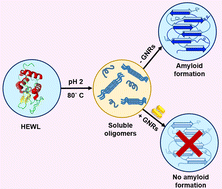Effects of the aspect ratio of plasmonic gold nanorods on the inhibition of lysozyme amyloid formation†
Abstract
Amyloid formation due to altered protein folding and aggregation has gained significant attention due to its association with neurodegenerative disorders such as Alzheimer's disease, Parkinson's disease, Huntington's disease, and systemic lysozyme amyloidosis. Amyloids are characterized by parallel and anti-parallel cross-β-strands arranged to form stacks of sheets that provide stability and rigidity to the amyloid core. The prototypic protein Hen Egg White Lysozyme (HEWL) has been extensively used to understand protein hydrolysis, fragmentation, folding, misfolding, and amyloid formation. In the present study, we have examined the efficacy of plasmonic gold nanorods (GNRs) as an anti-amyloid agent against HEWL amyloids. Our results reveal that (i) the amyloid inhibition by plasmonic GNRs is dependent on their aspect ratio, (ii) the large aspect ratio GNRs ameliorate amyloid assembly completely, and (iii) GNRs interfere at several stages along the lysozyme fibril-formation pathway and block the conversion of monomeric and oligomeric intermediates into mature fibrils. Using a multi-parametric approach, we demonstrate that GNRs drive HEWL into off-pathway and amyloid-incompetent forms. To establish GNRs as generic amyloid inhibitors, we extended our studies to another archetypal protein, Bovine Serum Albumin (BSA), and observed similar results of GNRs inhibiting BSA aggregation. We believe that our results will pave the way for the potential use of GNRs with current therapeutics to reduce the burden of amyloid-related diseases.



 Please wait while we load your content...
Please wait while we load your content...